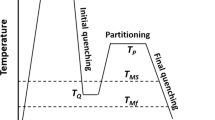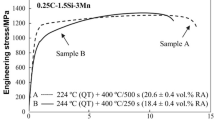Conclusions
-
1.
The lower the cooling rate after austenitizing, the higher the resistance to brittle fracture of structural steels.
-
2.
Susceptibility to brittle fracture increases with large isolated ferrite or ferrite and pearlite precipitates in the microstructure.
-
3.
Quenching from a temperature 250° above that generally used in production leads to a negligible increase in the susceptibility of steel 12Kh2MFA to brittle fracture.
Similar content being viewed by others
Literature cited
B. A. Drozdovskii and Ya. B. Fridman, Effect of Cracks on the Mechanical Properties of Structural Steels [in Russian], Metallurgizdat, Moscow (1960).
Additional information
A. A. Zhdanov Izhorskii Factory. Translated from Metallovedenie i Termicheskaya Obrabotka Metallov, No. 11, pp. 76–78, November, 1977.
Rights and permissions
About this article
Cite this article
Yakhnin, A.S. Effect of heat treatment on susceptibility to brittleness of structural steels. Met Sci Heat Treat 19, 997–999 (1977). https://doi.org/10.1007/BF00670176
Issue Date:
DOI: https://doi.org/10.1007/BF00670176




